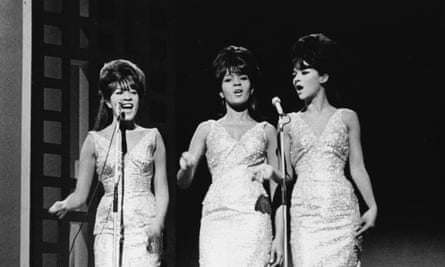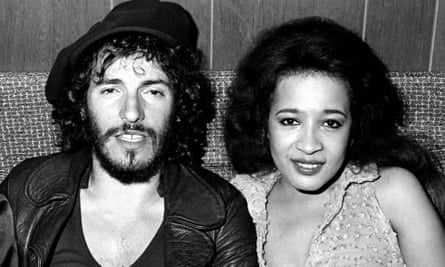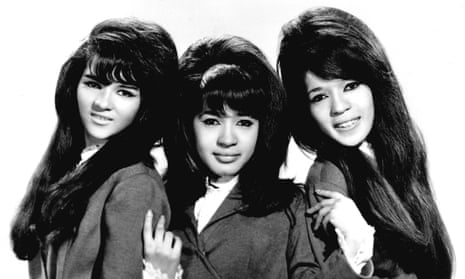The combination of the voice of Veronica Bennett, who has died aged 78, and Phil Spector’s studio-built Wall of Sound became one of the most potent and distinctive sounds to emerge from the fast-changing world of pop music in the early 1960s. Ronnie Spector, as she became when she and the producer married, was the lead singer of the Ronettes, a New York trio whose hits included Be My Baby, Baby I Love You, (The Best Part of) Breakin’ Up and – her own favourite – Walking in the Rain.
With their towering black beehive hairdos, extravagant eye makeup and tight sheath dresses, the Ronettes brought a whiff of sex and danger to the wholesome girl-group genre of the early 60s, previously dominated by the romantic songs of the Shirelles, the Chiffons and the Cookies. The sisters Veronica and Estelle Bennett and their cousin Nedra Talley projected an image that was a long way from any parent’s idea of a perfect prom date.
Among those they beguiled were the Beatles, whom they met at a party in Mayfair in 1964, and the Rolling Stones, with whom they toured the UK and hung out in New York. John Lennon took a particular shine to Ronnie as the American girls – who had begun as dancers in the Peppermint Lounge, a New York club – showed the four boys from Liverpool how to do the Pony, the Jerk and the Nitty Gritty. They dated in London, in a foursome made up by George Harrison and Estelle, sometimes accompanied by the girls’ mother, who was paying her first visit to London. Ronnie and John met again in the US, but her relationship with Spector was becoming more serious.
Forty years after their heyday, the Ronettes – and Ronnie in particular – would inspire the look developed by Amy Winehouse, who piled her hair high and drew winglets at the corners of her eyes in homage to the style they created during their teenage years in Harlem.

Veronica was the daughter of Louis Bennett, a subway worker, and his wife, Beatrice. He was white, she was black, and their combined ethnic heritage – African American, Native American, Irish – gave Veronica and her sister a paler skin tone and straighter hair than their fellow pupils at their Harlem school. “Hey, half-breed,” Veronica would be told, “get back on your reservation.” At one point she reacted by trying to dye her skin darker.
Music was a significant presence in the family. Her father played the drums, and groups of aunts and uncles formed vocal trios and quartets. Veronica sang from an early age, accompanied Estelle, the elder by two years, to dance classes, and knew from the age of 12, when she heard Frankie Lymon and the Teenagers, another bunch of Harlem teens, singing their hit Why Do Fools Fall in Love, that she wanted to be a performer. When Lymon, a star at 15, paid a visit to the Bennett house, she found herself having to resist his advances.
Her father had left the household and moved to Florida, suffering from alcoholism, by the time she enrolled at George Washington high school, where she decided that wearing nice clothes was a route to popularity. To pay for them, she took an after-school job serving meals to patients in the geriatric ward of a local hospital. At 15 she, Estelle and three girl cousins, including Nedra, and a boy cousin, Ira, performed Lymon’s hit during an amateur night at the celebrated Apollo theatre. Ira was due to take the lead part; when he froze with nerves at the microphone, Veronica stepped forward and earned applause that, she remembered, “made me feel like a star”.
Singing lessons for Veronica, Estelle and Nedra at a professional studio in midtown Manhattan led to a meeting with a songwriter, Stu Phillips, who gave them a song called What’s So Sweet About Sweet Sixteen and arranged for them to make their first records for the Colpix label. Two singles were released without success, but their career took a step forward when they auditioned as dancers at the Peppermint Lounge, a mob-run joint where celebrities were dancing the Twist to the music of Joey Dee and the Starliters. Despite being under the legal age to enter night clubs, and with tissue paper supplied by her mother to pad out the bras under their yellow taffeta dresses, they were hired.

Plans for them to appear alongside Dee in a movie titled Hey, Let’s Twist! foundered on the casting director’s verdict: “They’re too light to play black girls and too dark to play white girls. We can’t use them.” But the influential disc jockey Murray the K put them on his shows at the Brooklyn Fox in the spring of 1962, which was when they started teasing their hair into upward coils and applying the mascara with a more emphatic touch.
It was during the following year that they made a call to Phil Spector, whose hits with the Crystals (He’s a Rebel, Da Doo Ron Ron) and Bob B Soxx and the Blue Jeans (Zip-A-Dee-Doo-Dah) on his own Philles label had made him the hottest producer in pop. The Wagnerian scale of the orchestral arrangements on his records often threatened to overwhelm his singers, but in Veronica he found the perfect figure to stand atop his mountainous soundscapes.
Ronnie’s voice, marked by a slow, wide vibrato, combined the sweet optimism of adolescence with a sultry undertone that hinted at a more knowing sophistication. When Spector unleashed his echo-swathed battalions on a song called Be My Baby, it gave the Ronettes an immediate smash hit – and one that made a profound impression on other would-be hitmakers, including Brian Wilson of the Beach Boys, who listened to it endlessly.
Now they were the stars they had dreamed of being, and Ronnie was falling for her svengali, who was still married to his first wife. It was not until 1968, after the string of hits had dried up and Spector’s sound had fallen out of favour, that they were married. After a first, fruitless attempt to revive her career with a single called You Came, You Saw, You Conquered on the A&M label, in 1969 they adopted a son, Donté, Spector having made his wife wear a pillow under her clothes in order to convince the world that she was giving birth.
Phil Spector’s old friendship with the Beatles paid off when, in 1970, he was invited to finish off their Let It Be album and to produce solo records for Lennon and Harrison. He also took the opportunity to record one of Harrison’s songs, Try Some Buy Some, with Ronnie, again to minimal response, despite its release on the Beatles’ Apple label.
By now the marriage had been undermined by Phil Spector’s pathological jealousy. He locked his wife up in their Beverly Hills mansion and took away her shoes, allowed her to go out in a car alone only with a model of himself in the passenger seat to deter interest from other men, and threatened her with guns (a presentiment of the murder in 2003 of Lana Clarkson, for which he would spend the rest of his life in jail).

In 1972 he surprised Ronnie by presenting her with adopted twins, Gary and Louis, but within weeks, recognising that she and her husband were both suffering from alcohol addiction, she left him, after a violent exit in which her mother fought him off.
A lengthy and contested divorce eventually came through and in 1975 she began an independent solo career, which was given impetus by the attention of fans including Bruce Springsteen, his lieutenant Steve Van Zandt and Billy Joel. A duet with Eddie Money called Take Me Home Tonight returned her to the charts in 1986.
At 38 she had the first of two sons with Jonathan Greenfield, a stage production manager whom she had met in 1978. He became her manager and they married in 1982.
In 1988 she and her fellow Ronettes began the long process of suing Phil Spector for unpaid royalties. An initial award of $2.6m (£1.9m) was overturned, but eventually a settlement was reached in which they received an estimated $1m. In 1990 Ronnie wrote an autobiography, Be My Baby: How I Survived Mascara, Miniskirts and Madness, and in 2007 the Ronettes were inducted into the Rock and Roll Hall of Fame by Keith Richards. Ronnie released her final solo album, English Heart, in 2016.
Estelle died in 2009. Ronnie is survived by her husband, her sons, Jason, Austin, Donté, Gary and Louis, and her cousin Nedra, the third Ronette.

Comments (…)
Sign in or create your Guardian account to join the discussion